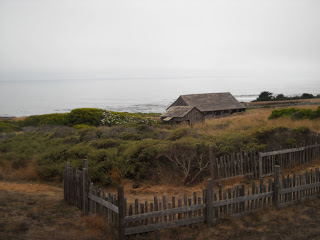In September 2012 my wife and I were invited by my employer to join him and his wife along with some friends of the shop on a Trek Travel bike tour of northern California. The trip began at the Sea Ranch Lodge, about 110 miles north of San Francisco, and finished in Sausalito with a side trip through San Francisco and up Mt Tam. The 5-Day tour took us down the Pacific Coast Highway with a few trips inland and spectacular views of the coast.
 Day One
Day One
The first day was spent taking the van from downtown San Francisco to the Sea Ranch Lodge, getting to
know our new friends and guides, and setting the Trek Madone bikes. After getting settled in at the lodge and setting up the bikes, we all headed out for a short ride up the Pacific Coast Highway and back before dinner.
Day Two
The second day began with breakfast facing the ocean, with a spectacular view of a whale surfacing while we ate. This was the first day with a significant ride, 42miles and a bit over 1300 feet of climbing in total planned. The route took us south down the Pacific Coast highway the entire trip, finishing at the Bodega Bay Lodge. I had never been to California and I was in awe of the view, and how close the highway was to the edge of
the United States in a couple sections. My wife and I rode by ourselves through most of the day, being joined a couple times by one of the guides and meeting up with a couple of the others from time to time. We were far more concerned with the view than our speed, as evidenced by the nearly three and a half hours we took to complete the 42 miles.
The ride finished at a ranch where we had lunch and went for a horseback ride. This made my wife very happy - she loves horses and it had been a long time since she'd ridden one. Although I don't dislike horses, I could do without strapping myself to the top of one of them. However, it was a fun ride on the trails around the ranch and everyone had a good time. We took the van from there to the Bodega Bay Lodge for the night.
I'll post part two very soon that includes our side trip into Bodega where the movie 'The Birds' was filmed!
 Day One
Day OneThe first day was spent taking the van from downtown San Francisco to the Sea Ranch Lodge, getting to
know our new friends and guides, and setting the Trek Madone bikes. After getting settled in at the lodge and setting up the bikes, we all headed out for a short ride up the Pacific Coast Highway and back before dinner.
 |
| The view from our window, Sea Ranch Lodge |
Day Two
 |
| My Wife, at the edge of the U.S. |
the United States in a couple sections. My wife and I rode by ourselves through most of the day, being joined a couple times by one of the guides and meeting up with a couple of the others from time to time. We were far more concerned with the view than our speed, as evidenced by the nearly three and a half hours we took to complete the 42 miles.
The ride finished at a ranch where we had lunch and went for a horseback ride. This made my wife very happy - she loves horses and it had been a long time since she'd ridden one. Although I don't dislike horses, I could do without strapping myself to the top of one of them. However, it was a fun ride on the trails around the ranch and everyone had a good time. We took the van from there to the Bodega Bay Lodge for the night.
 |
| My view of Hot Rod |
I'll post part two very soon that includes our side trip into Bodega where the movie 'The Birds' was filmed!

Comments
Post a Comment